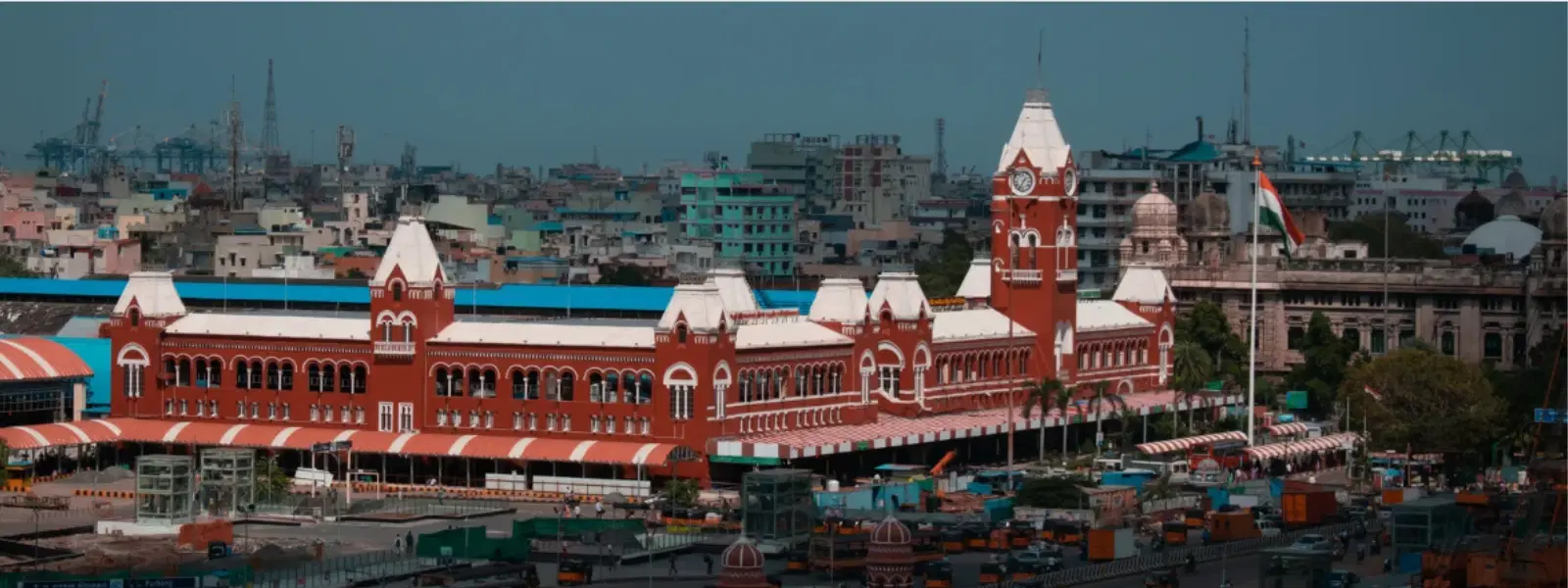
Hotels
•03 min read

Chennai’s architectural landscape is a living tapestry woven with history, culture, and art. The city proudly showcases a unique blend of traditional Indian motifs and colonial influences, embodied perfectly by Indo-Saracenic architecture. This style, which emerged during the British colonial era, marries Mughal elegance, Gothic grandeur, and indigenous design, forming striking structures that continue to shape Chennai’s cultural identity. In this blog, we explore frequently asked questions about Indo-Saracenic architecture in Chennai, delving into its origins, distinctive design elements, and the landmarks that make it unforgettable.
Indo-Saracenic architecture is an eclectic style that took shape during the British colonial period. This style is characterized by its majestic domes, graceful arches, towering minarets, and intricate carvings. The design seamlessly integrates Gothic structural forms with Mughal influences and traditional Indian artistry, resulting in a fusion that is both visually stunning and historically significant.
During the British Raj, Chennai, then known as Madras, emerged as a significant center for Indo-Saracenic architecture. Its strategic importance as a port city led to the construction of numerous government buildings and public institutions that adopted this unique style. These structures not only served administrative functions but also symbolized the blend of cultures that defined the era.
Chepauk Palace stands as one of Chennai’s earliest examples of Indo-Saracenic architecture. With its stately domes and expansive arches, the palace reflects the grandeur of the era and plays a crucial role in the city’s heritage. Its design elements have inspired countless subsequent structures, making it a touchstone for the local architectural narrative.
The Senate House at Madras University is renowned for its vibrant colors and impressive domes. Intricate carvings adorn its facades, exemplifying artistic excellence. This iconic building not only serves an educational purpose but also stands as a symbol of Chennai’s commitment to blending culture with academia.
The Madras High Court is celebrated as one of the largest judicial edifices in the world. Its commanding red-brick facade, crowned with domes and ornamental details, exemplifies Indo-Saracenic design at its best. This architectural marvel highlights the city’s ability to host monumental structures that convey both authority and beauty.

Victoria Public Hall has historically been a venue for public gatherings and cultural events, making it an enduring symbol of Chennai’s colonial past. Its classic arches and decorative features are reminders of a time when the fusion of British and Indian aesthetics created an unforgettable style.
What sets Indo-Saracenic architecture apart is its masterful integration of diverse influences. In Chennai, this style is a harmonious blend of Gothic rigidity, Mughal opulence, and traditional Indian finesse. The result is a series of structures that capture the imagination and reflect the city’s layered history.
Several design elements define these historic buildings. Domes rise gracefully above the structure, arches frame entrances with elegance, and minarets add a vertical dynamism. Stained glass windows and detailed carvings bring a touch of color and intricacy, all thoughtfully adapted to Chennai’s tropical climate and rich culture.
Local materials like red sandstone were favored not only for their durability but also for their vibrant hues that complement Chennai’s environment. Artisans applied traditional Indian craftsmanship to these constructions, ensuring that each piece of architecture tells its own story while standing as a monument to the era's innovative building methods.
These buildings are much more than mere structures; they are pages in the history book of Chennai. Representing the architectural heritage of the city, they capture the essence of a time when cultures met and exchanged ideas. This legacy not only attracts tourists from across India but also instills a deep sense of pride among locals, serving as a bridge between the past and present.
Despite their historical value, many Indo-Saracenic structures face threats from rapid urbanization, natural wear, and occasional neglect. Environmental factors further jeopardize their intricate details, prompting ongoing restoration and preservation efforts. These initiatives aim to maintain the integrity of Chennai’s historic buildings, ensuring that future generations can marvel at their beauty and historical importance.
Did You Know? Many Indo-Saracenic buildings in Chennai were designed by British architects who collaborated with Indian artisans, creating a unique architectural style that bridged two cultures.
Some notable examples include Chepauk Palace, Senate House at Madras University, Madras High Court, and Victoria Public Hall.
In Chennai, prominent monuments include the Madras High Court, Senate House, and Chepauk Palace, among others.
Chennai’s architecture is a blend of Dravidian temple architecture, colonial-era styles like Indo-Saracenic, and modern influences.
Chepauk Palace in Chennai is considered one of the earliest examples of Indo-Saracenic architecture in India.
It symbolizes the fusion of Indian and British architectural traditions, reflecting the cultural and historical exchanges during the colonial era.
Indo-Saracenic architecture has played a pivotal role in crafting Chennai’s identity as a city steeped in history and cultural richness. The fusion of artistic influences is evident in landmarks that continue to inspire awe and serve as repositories of the past. Exploring these structures provides not only a glimpse into a bygone era but also an appreciation for the architectural legacy that endures in the modern cityscape.